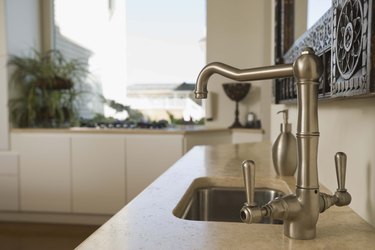 To design professionals, a countertop "edge" is an exposed side.
To design professionals, a countertop "edge" is an exposed side.
The difference between an eased-edge countertop and a countertop with a double-radius edge boils down to the degree to which the countertop is curved at its exposed edges. The difference is purely aesthetic. Double-radius countertops have a more dramatic curve than those with eased edges, producing a less-square, softer look.
Video of the Day
Edge Profiles
When home design professionals speak about countertop "edges," they're referring specifically to the exposed, finished edges of the countertop — not any side that meets a wall. On most countertops, these edges won't be perfectly square, 90-degree angles. Sharp angles can be dangerous. They're also prone to nicks and dents. And they can give a room an institutional look. For these reasons, countertop designers usually give a counter an "edge profile" involving bevels or curves. Eased edges and double-radius edges are among the most basic curved profiles.
Radiuses
The difference between eased and double-radius edges becomes clear when you understand how edge radiuses work. The top of the counter and the exposed side surface of the counter start out perpendicular, meeting at a 90-degree angle. When you sand, plane or grind down the area where they meet to create a curved edge, that curve is essentially one-quarter of a circle. The radius of that circle is the radius of the countertop edge. The larger the radius, the more prominent the curve on the edge.
Eased Edge
An eased edge is about as close as you can get to a square edge without creating a sharp angle. With an eased edge, the transition from the top of the countertop to the finished side is a curve with a radius of about one-eighth of an inch — a very small radius. On a typical eased edge, there are identical curves at both the top and bottom edges of the countertop slab. So, the finished surface goes from the top of the counter, over the top curved edge, down the vertical side of the edge, then over another curve as it wraps under the bottom of the counter.
Double-Radius Edge
A double-radius edge is set up the same way as an eased edge, but the curves at the top and bottom of the slab have a larger radius, typically about one-quarter of an inch. This creates a more dramatic curve profile. However, the curves don't meet in the middle of the edge. A portion of the edge still remains "flat." That's why these edges are called double-radius: There are two curves, one at the top and one at the edge. When a countertop edge has one big curve and no flat portion, the profile may be called a "full radius" or "bullnose" edge, depending on the angle of the curve.


